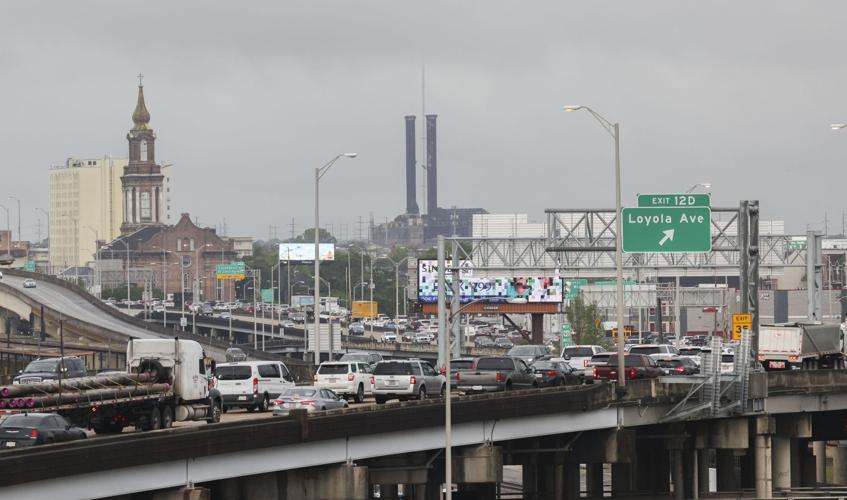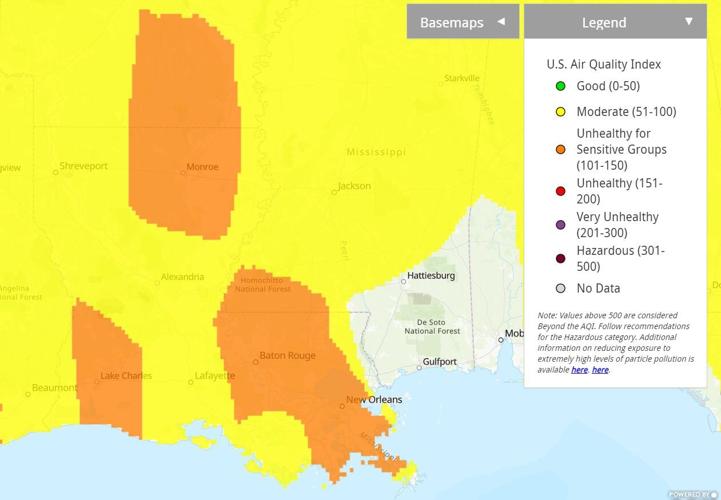The Louisiana Department of Environmental Quality has declared an ozone air quality action day for groups sensitive to health effects of the air pollutant in the Baton Rouge, New Orleans, Lake Charles and Monroe regions on Thursday, in part because of the effects of smoke, including from wildfires.
The "orange level" notices come as much of the Northeast and parts of the Midwest are also seeing even more significant health warnings, with some locations, including New York City, at the maroon or hazardous warning level for small particulate pollution because of smoke caused by wildfires in Ontario, Canada.
According to the EPA, when air quality is in this range, "people who are in sensitive groups, whether the increased risk is due to medical conditions, exposure conditions, or innate susceptibility, may experience health effects when engaged in outdoor activities. However, exposures to ambient concentrations in this range are not likely to result in effects in the general population."
According to a DEQ spokesman, only the Monroe area's warning is related to smoke reaching the northeastern part of the state from the Canada fires, and is only for ozone pollution, not for the small particulates caused by smoke.
"The advisory for Lake Charles is the result of transport of pollutants from Texas, while Baton Rouge and the rest of the state are just seeing a standard ozone action day alert, the result of sunny skies accompanied by high levels of ultraviolet rays and not much wind," said Gregory Langley, press secretary for the department.

The dots on this map show locations where smoke has been identified by satellite imagery within the past seven days. (NASA, National Forest Service)
However, Louisiana's ozone problem may also be exacerbated by nearby smoke, from industrial sources or small, local wildfires, or from larger wildfires in southeast Mississippi.
A map of fires or other sources of smoke that are active or have occurred in the past seven days in Louisiana and Mississippi, produced by the Fire Information for Research Management System, shows about 20 locations where fire or smoke are visible on satellite imagery along the Mississippi River from St. Bernard Parish north to the Louisiana state line, and more than 25 locations in parts of Louisiana and Texas near Lake Charles.
The map also shows three major active fires in southeast Mississippi that cover 1,000 acres or more.
Robert Frye, a lead forecaster with the Slidell office of the National Weather Service, said much of southern Louisiana is experiencing drought conditions, the result of low humidity and a lack of rainfall, that could result in wildfires.
"We are about a foot below normal for rainfall at the New Orleans International Airport this year, so it's really quite dry out there," Frye said.

This map shows areas with abnormally dry, yellow; and moderate drought, light orange, conditions. (U.S. Drought Monitor)
NOAA's National Integrated Drought Information System labels much of southeast Louisiana and a band of central Louisiana, just over 30% of the state, as abnormally dry, with another 6% in moderate drought, including all of Plaquemines Parish and parts of Jefferson, Lafourche, St. Charles, St. Bernard, Terrebonne, St. Mary and St. Martin parishes.
Wednesday also was listed as an air quality action day for Baton Rouge, and the conditions causing it could last through Friday, according to the joint EPA/DEQ Air Quality Index forecast.
"Light northerly to westerly winds will hinder dispersion and carry regional pollutants, including wildfire smoke, across Louisiana each day," each of the forecasts said. "In addition, partly sunny skies and highs in the low- to mid-90s will enhance ozone formation. Therefore, despite isolated thunderstorms reducing ozone at times, (air quality index levels) are expected to be moderate to unhealthy for sensistive groups on all three days.
The action day forecast urges residents to take one or more actions to help reduce ozone formation:
- Drive less. Carpool, walk and bike, combine errands and care for your car. Be sure your gas cap is on tight.
- Refuel your vehicle, mow grass and use gas-powered lawn equipment and off-road vehicles after 6 p.m.
- Postpone chores that use oil based paint, varnishes and solvents that produce flame.
- If you barbecue, use an electric starter instead of starter fluid.
- Take your lunch to work or walk to lunch.
- Conserve energy in your home.




